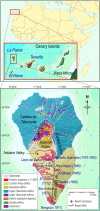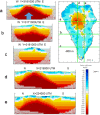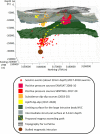Detection of volcanic unrest onset in La Palma, Canary Islands, evolution and implications
- PMID: 33510383
- PMCID: PMC7844277
- DOI: 10.1038/s41598-021-82292-3
Detection of volcanic unrest onset in La Palma, Canary Islands, evolution and implications
Abstract
La Palma island is one of the highest potential risks in the volcanic archipelago of the Canaries and therefore it is important to carry out an in-depth study to define its state of unrest. This has been accomplished through the use of satellite radar observations and an original state-of-the-art interpretation technique. Here we show the detection of the onset of volcanic unrest on La Palma island, most likely decades before a potential eruption. We study its current evolution seeing the spatial and temporal changing nature of activity at this potentially dangerous volcano at unprecedented spatial resolutions and long time scales, providing insights into the dynamic nature of the associated volcanic hazard. The geodetic techniques employed here allow tracking of the fluid migration induced by magma injection at depth and identifying the existence of dislocation sources below Cumbre Vieja volcano which could be associated with a future flank failure. Therefore they should continue being monitored using these and other techniques. The results have implications for the monitoring of steep-sided volcanoes at oceanic islands.
Conflict of interest statement
The authors declare no competing interests.
Figures








References
-
- Fernández J, González PJ, Camacho AG, Prieto JF, Brú G. An Overview of geodetic volcano research in the Canary Islands. Pure Appl. Geophys. 2015;172:3189–3228. doi: 10.1007/s00024-014-0916-6. - DOI
-
- Martí J, et al. Causes and mechanisms of the 2011–2012 El Hierro (Canary Islands) submarine eruption. J. Geophys. Res. Solid Earth. 2013;118:823–839. doi: 10.1002/jgrb.50087. - DOI
-
- Martí J, Ortiz R, Gottsmann J, Garcia A, De La Cruz-Reyna S. Characterising unrest during the reawakening of the central volcanic complex on Tenerife, Canary Islands, 2004–2005, and implications for assessing hazards and risk mitigation. J. Volcanol. Geotherm. Res. 2009;182:23–33. doi: 10.1016/j.jvolgeores.2009.01.028. - DOI
-
- Torres-González PA, et al. Unrest signals after 46 years of quiescence at Cumbre Vieja, La Palma, Canary Islands. J. Volcanol. Geotherm. Res. 2020;392:106757. doi: 10.1016/j.jvolgeores.2019.106757. - DOI
-
- Staudigel H, Feraud G, Giannerini G. The history of intrusive activity on the Island of La Palma (Canary Islands) J. Volcanol. Geotherm. Res. 1986;27:299–322. doi: 10.1016/0377-0273(86)90018-1. - DOI
Grants and funding
- RTI2018-093874-B-I00/the Spanish Ministerio de Ciencia, Innovación y Universidades
- RTI2018-093874-B-I00/the Spanish Ministerio de Ciencia, Innovación y Universidades
- RTI2018-093874-B-I00/the Spanish Ministerio de Ciencia, Innovación y Universidades
- RTI2018-093874-B-I00/the Spanish Ministerio de Ciencia, Innovación y Universidades
- RTI2018-093874-B-I00/the Spanish Ministerio de Ciencia, Innovación y Universidades
- RTI2018-093874-B-I00/the Spanish Ministerio de Ciencia, Innovación y Universidades
- RTI2018-093874-B-I00/the Spanish Ministerio de Ciencia, Innovación y Universidades
- RTI2018-093874-B-I00/the Spanish Ministerio de Ciencia, Innovación y Universidades
- RTI2018-093874-B-I00/the Spanish Ministerio de Ciencia, Innovación y Universidades
- RTI2018-093874-B-I00/the Spanish Ministerio de Ciencia, Innovación y Universidades
- 201530E019/Consejo Superior de Investigaciones Científicas
- 201530E019/Consejo Superior de Investigaciones Científicas
- 201530E019/Consejo Superior de Investigaciones Científicas
- 201530E019/Consejo Superior de Investigaciones Científicas
- AYA2010-17448/Spanish Ministerio de Ciencia e Innovación
- AYA2010-17448/Spanish Ministerio de Ciencia e Innovación
- AYA2010-17448/Spanish Ministerio de Ciencia e Innovación
- AYA2010-17448/Spanish Ministerio de Ciencia e Innovación
- CGL2017-86241-R/Ministerio de Economía, Industria y Competitividad, Gobierno de España
LinkOut - more resources
Full Text Sources
Other Literature Sources

